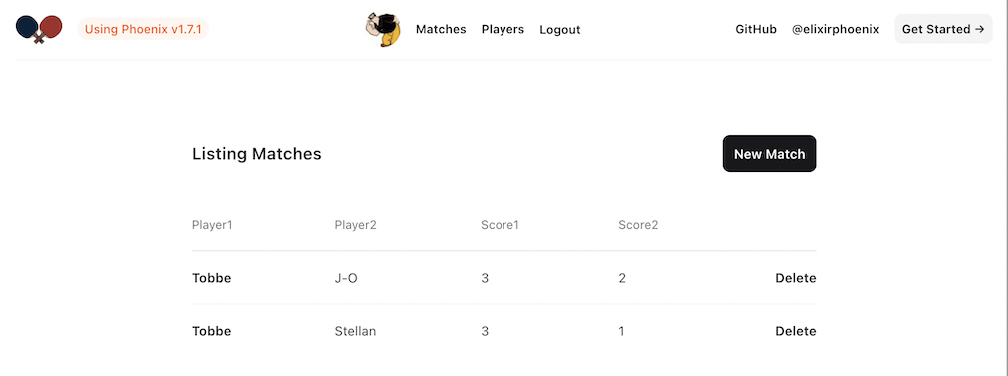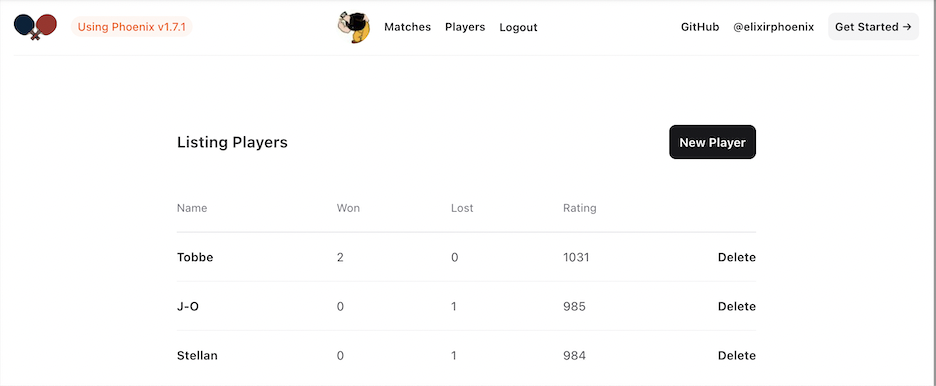Revisiting my old Table Tennis Score System, now as a tool to learn Elixir+Phoenix.
A player can be created by logging in via any of the GitHub, Twitter or Google authentication providers.
Then matches can be stored between two players.
A rating figure is calculated so that you don't have to guess who is the best Table Tennis player...
You need to have Elixir and Postgres installed. See below.
Make sure to configure the Postgres user and password in
the config/dev.exs file. You can also change the IP/Port
in this file.
For authentication, see below how to enable it for the various providers.
To start your Phoenix server:
- Run
mix setupto install and setup dependencies - Start Phoenix endpoint with
mix phx.serveror inside IEx withiex -S mix phx.server
Now you can visit localhost:4040 from your browser.
To setup your own Table Tennis server and make Github login possible you need to create your OAuth-app at github, see here how to do it: https://docs.github.com/en/apps/oauth-apps/building-oauth-apps/creating-an-oauth-app
You will need to create a client-id and a client-secretthat you
store in environment variables like this:
# Client ID and Secret
export GITHUB_CLIENT_ID=<client-id>
export GITHUB_CLIENT_SECRET=<client-secret>
Don't forget to add your callback URL to the white list.
To setup your own Table Tennis server and make Twitter login possible you need to create your app at the Twitter developer portal (https://apps.twitter.com). Then you need to create the API-Key and Secret and store them in the environment variables like this:
# Consumer Keys: API Key and Secret
export TWITTER_CONSUMER_KEY=<consumer-key>
export TWITTER_CONSUMER_SECRET=<consumer-secret>
You also need to setup your callback URL in a whitelist.
You do that under the User authentication settings and it looks
typically like this:
http://localhost:4040/auth/twitter/callback
A website URL is also requested but that can be whatever it seems.
You also need to enable Request email from users which will
require you to fill in URL pointing to your Terms of service
and Privacy Policy.
Have a look here: https://www.balbooa.com/gridbox-documentation/how-to-get-google-client-id-and-client-secret
You will need to create a client-id and a client-secretthat you
store in environment variables like this:
# Client ID and Secret
export GOOGLE_CLIENT_ID=<client-id>
export GOOGLE_CLIENT_SECRET=<client-secret>
Don't forget to add your callback URL to the white list.
Assuming Debian, we are using asdf in order to handle multiple versions
of Erlang and Elixir.
# Install asdf
git clone https://github.com/asdf-vm/asdf.git ~/.asdf --branch v0.11.3
# Setup asdf
$ tail -3 ~/.bashrc
# https://asdf-vm.com/guide/getting-started.html#community-supported-download-methods
. "$HOME/.asdf/asdf.sh"
. "$HOME/.asdf/completions/asdf.bash"
# Install Erlang
asdf plugin add erlang https://github.com/asdf-vm/asdf-erlang.git
asdf install erlang 25.3
asdf global erlang 25.3
# Install Elixir
asdf plugin-add elixir https://github.com/asdf-vm/asdf-elixir.git
asdf install elixir 1.14.4
asdf global elixir 1.14.4
# Install Phoenix
mix local.hex
mix archive.install hex phx_new
# Install Postgres
# https://wiki.debian.org/PostgreSql
sudo apt install postgresql postgresql-client
Ready to run in production? Please check our deployment guides.
- Official website: https://www.phoenixframework.org/
- Guides: https://hexdocs.pm/phoenix/overview.html
- Docs: https://hexdocs.pm/phoenix
- Forum: https://elixirforum.com/c/phoenix-forum
- Source: https://github.com/phoenixframework/phoenix
Here I have some notes I've jotted down while learning the ropes of this cool framework.
Phoenix is a web development framework written in Elixir which implements the server-side Model View Controller (MVC) pattern.
The Phoenix endpoint pipeline takes a request, routes it to a controller to access the Model (Business Logic), which then calls a view module to render a template.
The Model will be responsible to host all of your business logic and business domain. It typically interacts directly with the database.
Controllers act as intermediary modules. Their functions, called actions, are invoked from the router in response to HTTP requests. The actions, in turn, gather all the necessary data (e.g from the Model) and perform all the necessary steps before invoking the view layer. Phoenix controllers also build on the Plug package, and are themselves plugs.
The view interface from the controller is simple – the controller calls a view function with the connections assigns, and the functions job is to return a HEEx template. We call any function that accepts an assigns parameter and returns a HEEx template to be a function component.
mix phx.new table_tennis
cd table_tennis
mix phx.gen.html App Player players name:string won:integer lost:integer rating:integer
mix phx.gen.html App Match matches player1:string player2:string score1:integer score2:integer
mix ecto.migrate
Change the password:
ALTER USER <user> WITH PASSWORD '<new-password>';
If POSTGRES table already exist when: mix ecto.migrate
psql -U postgres -c 'DROP DATABASE IF EXISTS table_tennis_dev;'
or perhaps better:
mix ecto.drop
then:
mix ecto.create
or even better:
mix ecto.reset
to undo e.g a migration:
mix ecto.rollback
Working with psql:
psql table_tennis_dev - connect to the
\dt - list tables
\d players - list the fields in the 'players' table
Working with Ecto from the shell:
alias TableTennis.Repo
import Ecto.Query
# Check what SQL is generated
query = from "players", select: [:name]
Repo.to_sql(:all, query)

